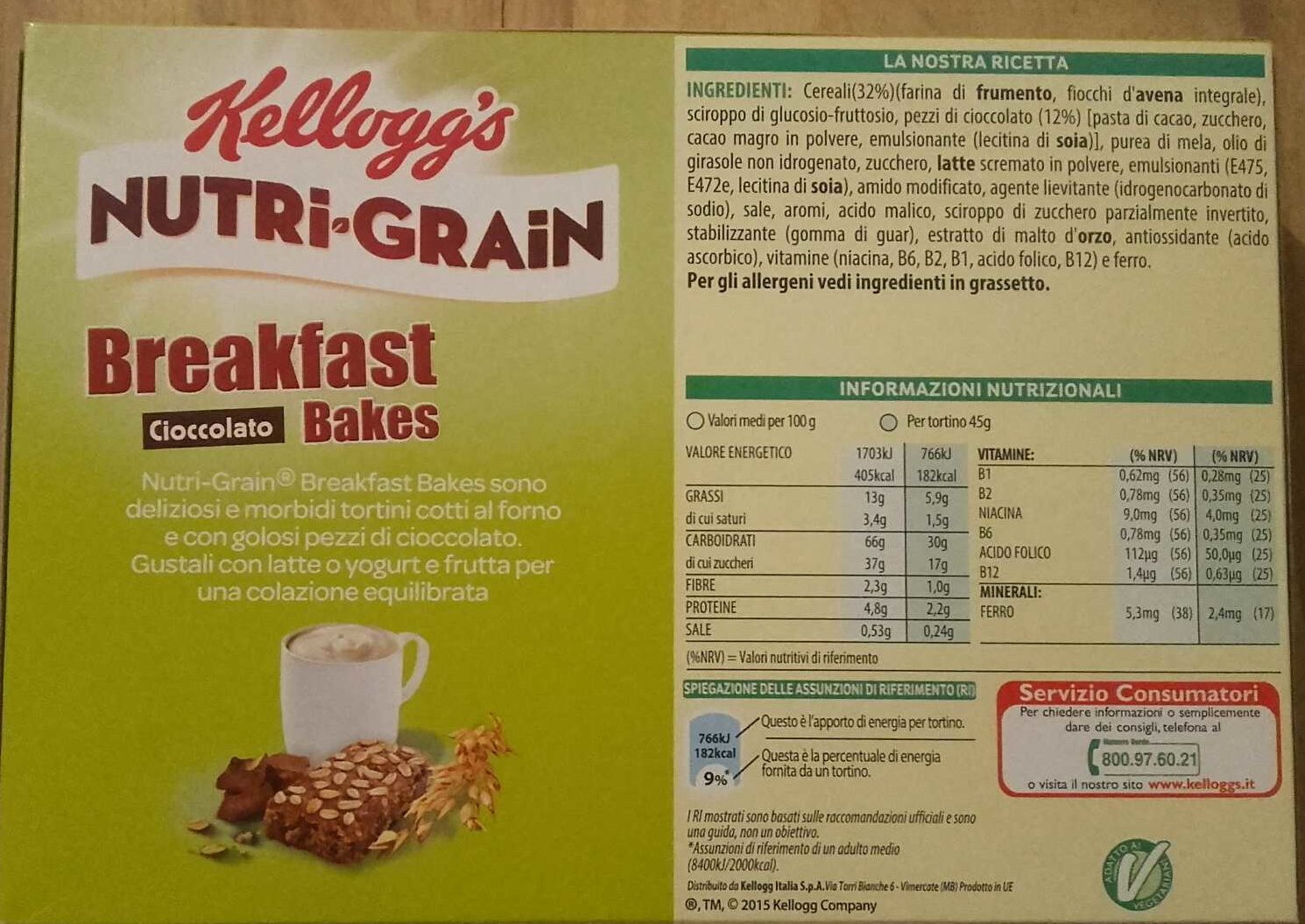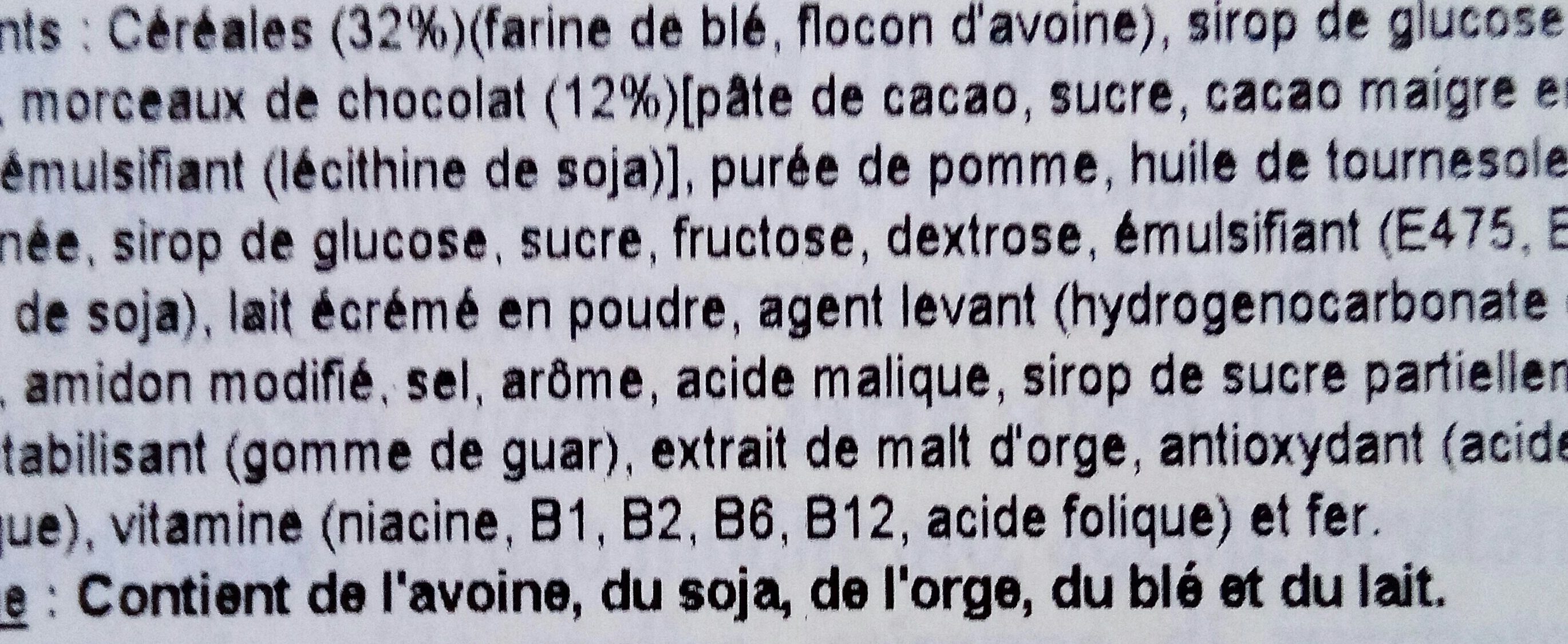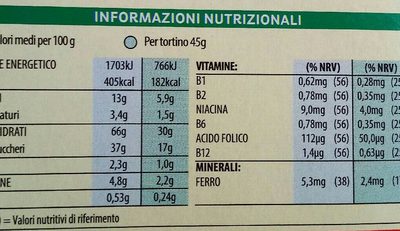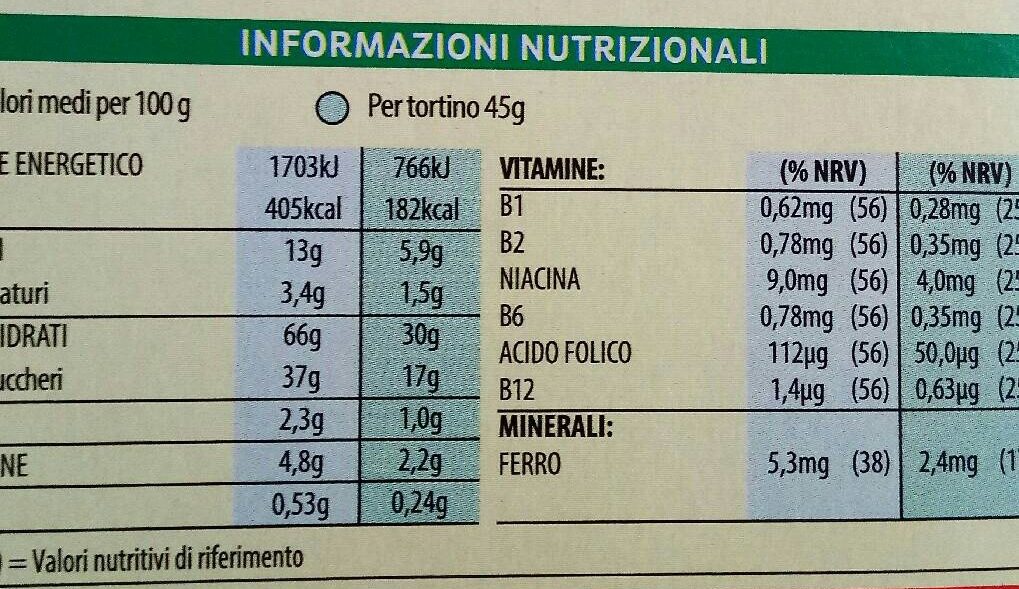Help us make food transparency the norm!
As a non-profit organization, we depend on your donations to continue informing consumers around the world about what they eat.
The food revolution starts with you!
Breakfast Bakes Chocolate - Kellogg's - 270 g (6 * 45 g)
Breakfast Bakes Chocolate - Kellogg's - 270 g (6 * 45 g)
This product page is not complete. You can help to complete it by editing it and adding more data from the photos we have, or by taking more photos using the app for Android or iPhone/iPad. Thank you!
×
Barcode: 5053827118699 (EAN / EAN-13)
Common name: Gâteau de blé et d'avoine avec morceaux de chocolat et vitamines ajoutées (niacine, B6, B2, B1, acide folique, B12) et fer.
Quantity: 270 g (6 * 45 g)
Packaging: Plastic, Box, Cardboard
Brands: Kellogg's
Categories: Snacks, Sweet snacks, Biscuits and cakes, Biscuits, Cakes, Chocolate cakes
Labels, certifications, awards: Vegetarian
Matching with your preferences
Health
Ingredients
-
39 ingredients
: Céréales (farine de blé, flocon d'avoine), sirop de glucose, morceaux de chocolat de cacao, sucre, cacao maigre, émulsifiant (lécithine de soja)), purée de pomme, huile de tournesol émulsionnée, sirop de glucose, sucre, fructose, dextrose, émulsifiant (E475, lécithine de soja), lait écrémé en poudre, agent levant (hydrogénocarbonate de sodium, amidon modifié, sel, arôme, acide malique, sirop de sucre partiellement inverti, stabilisant (gomme de guar), extrait de malt d'orge, antioxydant (acide lactique), vitamine (niacine, B1, B2, B6, B12, acide folique) et fer.Allergens: Gluten, Milk, Soybeans, fr:avoine
Food processing
-
Ultra processed foods
Elements that indicate the product is in the 4 - Ultra processed food and drink products group:
- Additive: E14XX - Modified Starch
- Additive: E322 - Lecithins
- Additive: E412 - Guar gum
- Additive: E475 - Polyglycerol esters of fatty acids
- Ingredient: Dextrose
- Ingredient: Emulsifier
- Ingredient: Flavouring
- Ingredient: Glucose
- Ingredient: Glucose syrup
- Ingredient: Invert sugar
Food products are classified into 4 groups according to their degree of processing:
- Unprocessed or minimally processed foods
- Processed culinary ingredients
- Processed foods
- Ultra processed foods
The determination of the group is based on the category of the product and on the ingredients it contains.
Additives
-
E270 - Lactic acid
Lactic acid: Lactic acid is an organic compound with the formula CH3CH-OH-COOH. In its solid state, it is white and water-soluble. In its liquid state, it is colorless. It is produced both naturally and synthetically. With a hydroxyl group adjacent to the carboxyl group, lactic acid is classified as an alpha-hydroxy acid -AHA-. In the form of its conjugate base called lactate, it plays a role in several biochemical processes. In solution, it can ionize a proton from the carboxyl group, producing the lactate ion CH3CH-OH-CO−2. Compared to acetic acid, its pKa is 1 unit less, meaning lactic acid deprotonates ten times more easily than acetic acid does. This higher acidity is the consequence of the intramolecular hydrogen bonding between the α-hydroxyl and the carboxylate group. Lactic acid is chiral, consisting of two optical isomers. One is known as L--+--lactic acid or -S--lactic acid and the other, its mirror image, is D--−--lactic acid or -R--lactic acid. A mixture of the two in equal amounts is called DL-lactic acid, or racemic lactic acid. Lactic acid is hygroscopic. DL-lactic acid is miscible with water and with ethanol above its melting point which is around 17 or 18 °C. D-lactic acid and L-lactic acid have a higher melting point. In animals, L-lactate is constantly produced from pyruvate via the enzyme lactate dehydrogenase -LDH- in a process of fermentation during normal metabolism and exercise. It does not increase in concentration until the rate of lactate production exceeds the rate of lactate removal, which is governed by a number of factors, including monocarboxylate transporters, concentration and isoform of LDH, and oxidative capacity of tissues. The concentration of blood lactate is usually 1–2 mM at rest, but can rise to over 20 mM during intense exertion and as high as 25 mM afterward. In addition to other biological roles, L-lactic acid is the primary endogenous agonist of hydroxycarboxylic acid receptor 1 -HCA1-, which is a Gi/o-coupled G protein-coupled receptor -GPCR-.In industry, lactic acid fermentation is performed by lactic acid bacteria, which convert simple carbohydrates such as glucose, sucrose, or galactose to lactic acid. These bacteria can also grow in the mouth; the acid they produce is responsible for the tooth decay known as caries. In medicine, lactate is one of the main components of lactated Ringer's solution and Hartmann's solution. These intravenous fluids consist of sodium and potassium cations along with lactate and chloride anions in solution with distilled water, generally in concentrations isotonic with human blood. It is most commonly used for fluid resuscitation after blood loss due to trauma, surgery, or burns.Source: Wikipedia
-
E296 - Malic acid
Malic acid: Malic acid is an organic compound with the molecular formula C4H6O5. It is a dicarboxylic acid that is made by all living organisms, contributes to the pleasantly sour taste of fruits, and is used as a food additive. Malic acid has two stereoisomeric forms -L- and D-enantiomers-, though only the L-isomer exists naturally. The salts and esters of malic acid are known as malates. The malate anion is an intermediate in the citric acid cycle.Source: Wikipedia
-
E322 - Lecithins
Lecithins are natural compounds commonly used in the food industry as emulsifiers and stabilizers.
Extracted from sources like soybeans and eggs, lecithins consist of phospholipids that enhance the mixing of oil and water, ensuring smooth textures in various products like chocolates, dressings, and baked goods.
They do not present any known health risks.
-
E322i - Lecithin
Lecithins are natural compounds commonly used in the food industry as emulsifiers and stabilizers.
Extracted from sources like soybeans and eggs, lecithins consist of phospholipids that enhance the mixing of oil and water, ensuring smooth textures in various products like chocolates, dressings, and baked goods.
They do not present any known health risks.
-
E412 - Guar gum
Guar gum (E412) is a natural food additive derived from guar beans.
This white, odorless powder is valued for its remarkable thickening and stabilizing properties, making it a common ingredient in various food products, including sauces, dressings, and ice creams.
When used in moderation, guar gum is considered safe for consumption, with no known adverse health effects.
-
E500 - Sodium carbonates
Sodium carbonates (E500) are compounds commonly used in food preparation as leavening agents, helping baked goods rise by releasing carbon dioxide when they interact with acids.
Often found in baking soda, they regulate the pH of food, preventing it from becoming too acidic or too alkaline. In the culinary world, sodium carbonates can also enhance the texture and structure of foods, such as noodles, by modifying the gluten network.
Generally recognized as safe, sodium carbonates are non-toxic when consumed in typical amounts found in food.
-
E500ii - Sodium hydrogen carbonate
Sodium hydrogen carbonate, also known as E500ii, is a food additive commonly used as a leavening agent.
When added to recipes, it releases carbon dioxide gas upon exposure to heat or acids, causing dough to rise and resulting in a light, fluffy texture in baked goods.
It is generally recognized as safe (GRAS) by regulatory authorities when used in appropriate quantities and poses no significant health risks when consumed in typical food applications.
Ingredients analysis
-
Palm oil free
No ingredients containing palm oil detected
Unrecognized ingredients: fr:morceaux-de-chocolat-de-cacao, fr:huile-de-tournesol-emulsionneeSome ingredients could not be recognized.
We need your help!
You can help us recognize more ingredients and better analyze the list of ingredients for this product and others:
- Edit this product page to correct spelling mistakes in the ingredients list, and/or to remove ingredients in other languages and sentences that are not related to the ingredients.
- Add new entries, synonyms or translations to our multilingual lists of ingredients, ingredient processing methods, and labels.
If you would like to help, join the #ingredients channel on our Slack discussion space and/or learn about ingredients analysis on our wiki. Thank you!
-
Non-vegan
Non-vegan ingredients: Skimmed milk powderSome ingredients could not be recognized.
We need your help!
You can help us recognize more ingredients and better analyze the list of ingredients for this product and others:
- Edit this product page to correct spelling mistakes in the ingredients list, and/or to remove ingredients in other languages and sentences that are not related to the ingredients.
- Add new entries, synonyms or translations to our multilingual lists of ingredients, ingredient processing methods, and labels.
If you would like to help, join the #ingredients channel on our Slack discussion space and/or learn about ingredients analysis on our wiki. Thank you!
-
Vegetarian
No non-vegetarian ingredients detected
Unrecognized ingredients: fr:morceaux-de-chocolat-de-cacao, fr:huile-de-tournesol-emulsionnee, Thiamin, Vitamin b12, Folic acid, IronSome ingredients could not be recognized.
We need your help!
You can help us recognize more ingredients and better analyze the list of ingredients for this product and others:
- Edit this product page to correct spelling mistakes in the ingredients list, and/or to remove ingredients in other languages and sentences that are not related to the ingredients.
- Add new entries, synonyms or translations to our multilingual lists of ingredients, ingredient processing methods, and labels.
If you would like to help, join the #ingredients channel on our Slack discussion space and/or learn about ingredients analysis on our wiki. Thank you!
-
Details of the analysis of the ingredients
We need your help!
Some ingredients could not be recognized.
We need your help!
You can help us recognize more ingredients and better analyze the list of ingredients for this product and others:
- Edit this product page to correct spelling mistakes in the ingredients list, and/or to remove ingredients in other languages and sentences that are not related to the ingredients.
- Add new entries, synonyms or translations to our multilingual lists of ingredients, ingredient processing methods, and labels.
If you would like to help, join the #ingredients channel on our Slack discussion space and/or learn about ingredients analysis on our wiki. Thank you!
: Céréales (farine de _blé_, flocon d'_avoine_), sirop de glucose, morceaux de chocolat de cacao, sucre, cacao maigre, émulsifiant (lécithine de _soja_), purée de pomme, huile de tournesol émulsionnée, sirop de glucose, sucre, fructose, dextrose, émulsifiant (e475, lécithine de _soja_), _lait_ écrémé en poudre, agent levant, hydrogénocarbonate de sodium, amidon modifié, sel, arôme, acide malique, sirop de sucre partiellement inverti, stabilisant (gomme de guar), extrait de malt d'_orge_, antioxydant (acide lactique), vitamines, niacine, vitamine B1, vitamine B2, vitamine B6, vitamine B12, acide folique, fer- Céréales -> en:cereal - vegan: yes - vegetarian: yes - percent_min: 3.125 - percent_max: 100
- farine de _blé_ -> en:wheat-flour - vegan: yes - vegetarian: yes - ciqual_proxy_food_code: 9410 - percent_min: 1.5625 - percent_max: 100
- flocon d'_avoine_ -> en:oat-flakes - vegan: yes - vegetarian: yes - ciqual_food_code: 9311 - percent_min: 0 - percent_max: 50
- sirop de glucose -> en:glucose-syrup - vegan: yes - vegetarian: yes - ciqual_proxy_food_code: 31016 - percent_min: 0 - percent_max: 50
- morceaux de chocolat de cacao -> fr:morceaux-de-chocolat-de-cacao - percent_min: 0 - percent_max: 33.3333333333333
- sucre -> en:sugar - vegan: yes - vegetarian: yes - ciqual_proxy_food_code: 31016 - percent_min: 0 - percent_max: 25
- cacao maigre -> en:fat-reduced-cocoa - vegan: yes - vegetarian: yes - ciqual_proxy_food_code: 18100 - percent_min: 0 - percent_max: 20
- émulsifiant -> en:emulsifier - percent_min: 0 - percent_max: 16.6666666666667
- lécithine de _soja_ -> en:soya-lecithin - vegan: yes - vegetarian: yes - ciqual_food_code: 42200 - percent_min: 0 - percent_max: 16.6666666666667
- purée de pomme -> en:apple-puree - vegan: maybe - vegetarian: maybe - ciqual_food_code: 13050 - percent_min: 0 - percent_max: 14.2857142857143
- huile de tournesol émulsionnée -> fr:huile-de-tournesol-emulsionnee - percent_min: 0 - percent_max: 12.5
- sirop de glucose -> en:glucose-syrup - vegan: yes - vegetarian: yes - ciqual_proxy_food_code: 31016 - percent_min: 0 - percent_max: 11.1111111111111
- sucre -> en:sugar - vegan: yes - vegetarian: yes - ciqual_proxy_food_code: 31016 - percent_min: 0 - percent_max: 10
- fructose -> en:fructose - vegan: yes - vegetarian: yes - ciqual_food_code: 31077 - percent_min: 0 - percent_max: 9.09090909090909
- dextrose -> en:dextrose - vegan: yes - vegetarian: yes - ciqual_proxy_food_code: 31016 - percent_min: 0 - percent_max: 8.33333333333333
- émulsifiant -> en:emulsifier - percent_min: 0 - percent_max: 7.69230769230769
- e475 -> en:e475 - vegan: maybe - vegetarian: maybe - percent_min: 0 - percent_max: 7.69230769230769
- lécithine de _soja_ -> en:soya-lecithin - vegan: yes - vegetarian: yes - ciqual_food_code: 42200 - percent_min: 0 - percent_max: 3.84615384615385
- _lait_ écrémé en poudre -> en:skimmed-milk-powder - vegan: no - vegetarian: yes - ciqual_food_code: 19054 - percent_min: 0 - percent_max: 7.14285714285714
- agent levant -> en:raising-agent - percent_min: 0 - percent_max: 6.66666666666667
- hydrogénocarbonate de sodium -> en:e500ii - vegan: yes - vegetarian: yes - percent_min: 0 - percent_max: 6.25
- amidon modifié -> en:modified-starch - vegan: yes - vegetarian: yes - ciqual_proxy_food_code: 9510 - percent_min: 0 - percent_max: 5.88235294117647
- sel -> en:salt - vegan: yes - vegetarian: yes - ciqual_food_code: 11058 - percent_min: 0 - percent_max: 0.53
- arôme -> en:flavouring - vegan: maybe - vegetarian: maybe - percent_min: 0 - percent_max: 0.53
- acide malique -> en:e296 - vegan: yes - vegetarian: yes - percent_min: 0 - percent_max: 0.53
- sirop de sucre partiellement inverti -> en:partially-inverted-sugar-syrup - vegan: yes - vegetarian: yes - percent_min: 0 - percent_max: 0.53
- stabilisant -> en:stabiliser - percent_min: 0 - percent_max: 0.53
- gomme de guar -> en:e412 - vegan: yes - vegetarian: yes - percent_min: 0 - percent_max: 0.53
- extrait de malt d'_orge_ -> en:barley-malt-extract - vegan: yes - vegetarian: yes - percent_min: 0 - percent_max: 0.53
- antioxydant -> en:antioxidant - percent_min: 0 - percent_max: 0.53
- acide lactique -> en:e270 - vegan: yes - vegetarian: yes - percent_min: 0 - percent_max: 0.53
- vitamines -> en:vitamins - vegan: yes - vegetarian: yes - percent_min: 0 - percent_max: 0.53
- niacine -> en:e375 - vegan: maybe - vegetarian: maybe - percent_min: 0 - percent_max: 0.53
- vitamine B1 -> en:thiamin - percent_min: 0 - percent_max: 0.53
- vitamine B2 -> en:e101 - vegan: maybe - vegetarian: yes - percent_min: 0 - percent_max: 0.53
- vitamine B6 -> en:vitamin-b6 - vegan: yes - vegetarian: yes - percent_min: 0 - percent_max: 0.53
- vitamine B12 -> en:vitamin-b12 - percent_min: 0 - percent_max: 0.53
- acide folique -> en:folic-acid - percent_min: 0 - percent_max: 0.53
- fer -> en:iron - percent_min: 0 - percent_max: 0.53
Nutrition
-
Poor nutritional quality
⚠ ️Warning: the amount of fruits, vegetables and nuts is not specified on the label, it was estimated from the list of ingredients: 0This product is not considered a beverage for the calculation of the Nutri-Score.
Positive points: 2
- Proteins: 2 / 5 (value: 4.8, rounded value: 4.8)
- Fiber: 2 / 5 (value: 2.3, rounded value: 2.3)
- Fruits, vegetables, nuts, and colza/walnut/olive oils: 0 / 5 (value: 0.7568359375, rounded value: 0.8)
Negative points: 18
- Energy: 5 / 10 (value: 1695, rounded value: 1695)
- Sugars: 8 / 10 (value: 37, rounded value: 37)
- Saturated fat: 3 / 10 (value: 3.4, rounded value: 3.4)
- Sodium: 2 / 10 (value: 212, rounded value: 212)
The points for proteins are not counted because the negative points are greater or equal to 11.
Nutritional score: (18 - 2)
Nutri-Score:
-
Nutrient levels
-
Fat in moderate quantity (13%)
What you need to know- A high consumption of fat, especially saturated fats, can raise cholesterol, which increases the risk of heart diseases.
Recommendation: Limit the consumption of fat and saturated fat- Choose products with lower fat and saturated fat content.
-
Saturated fat in moderate quantity (3.4%)
What you need to know- A high consumption of fat, especially saturated fats, can raise cholesterol, which increases the risk of heart diseases.
Recommendation: Limit the consumption of fat and saturated fat- Choose products with lower fat and saturated fat content.
-
Sugars in high quantity (37%)
What you need to know- A high consumption of sugar can cause weight gain and tooth decay. It also augments the risk of type 2 diabetes and cardio-vascular diseases.
Recommendation: Limit the consumption of sugar and sugary drinks- Sugary drinks (such as sodas, fruit beverages, and fruit juices and nectars) should be limited as much as possible (no more than 1 glass a day).
- Choose products with lower sugar content and reduce the consumption of products with added sugars.
-
Salt in moderate quantity (0.53%)
What you need to know- A high consumption of salt (or sodium) can cause raised blood pressure, which can increase the risk of heart disease and stroke.
- Many people who have high blood pressure do not know it, as there are often no symptoms.
- Most people consume too much salt (on average 9 to 12 grams per day), around twice the recommended maximum level of intake.
Recommendation: Limit the consumption of salt and salted food- Reduce the quantity of salt used when cooking, and don't salt again at the table.
- Limit the consumption of salty snacks and choose products with lower salt content.
-
-
Nutrition facts
Nutrition facts As sold
for 100 g / 100 mlAs sold
per serving (45 g)Compared to: Chocolate cakes Energy 1,695 kj
(405 kcal)763 kj
(182 kcal)-5% Fat 13 g 5.85 g -42% Saturated fat 3.4 g 1.53 g -57% Carbohydrates 66 g 29.7 g +34% Sugars 37 g 16.6 g +20% Fiber 2.3 g 1.03 g -20% Proteins 4.8 g 2.16 g -16% Salt 0.53 g 0.238 g +4% Fruits‚ vegetables‚ nuts and rapeseed‚ walnut and olive oils (estimate from ingredients list analysis) 0.757 % 0.757 %
Environment
-
Eco-Score D - High environmental impact
⚠ ️Select a country in order to include the full impact of transportation.The Eco-Score is an experimental score that summarizes the environmental impacts of food products.→ The Eco-Score was initially developped for France and it is being extended to other European countries. The Eco-Score formula is subject to change as it is regularly improved to make it more precise and better suited to each country.Life cycle analysis
-
Average impact of products of the same category: C (Score: 47/100)
Category: Chocolate cake
Category: Chocolate cake
- PEF environmental score: 0.60 (the lower the score, the lower the impact)
- including impact on climate change: 7.88 kg CO2 eq/kg of product
Stage Impact Agriculture
48.2 %Processing
45.1 %Packaging
3.2 %Transportation
2.7 %Distribution
0.8 %Consumption
0.0 %
Bonuses and maluses
-
Missing origins of ingredients information
Malus: -5
⚠ ️ The origins of the ingredients of this product are not indicated.
If they are indicated on the packaging, you can modify the product sheet and add them.
If you are the manufacturer of this product, you can send us the information with our free platform for producers.
-
Packaging with a medium impact
Malus: -11
Shape Material Recycling Impact Box Plastic High Unknown Cardboard Low ⚠ ️ The information about the packaging of this product is not sufficiently precise (exact shapes and materials of all components of the packaging).⚠ ️ For a more precise calculation of the Eco-Score, you can modify the product page and add them.
If you are the manufacturer of this product, you can send us the information with our free platform for producers.
Eco-Score for this product
-
Impact for this product: D (Score: 31/100)
Product: Breakfast Bakes Chocolate - Kellogg's - 270 g (6 * 45 g)
Life cycle analysis score: 47
Sum of bonuses and maluses: -16
Final score: 31/100
-
Carbon footprint
-
Equal to driving 4.1 km in a petrol car
788 g CO² per 100g of product
The carbon emission figure comes from ADEME's Agribalyse database, for the category: Chocolate cake (Source: ADEME Agribalyse Database)
Stage Impact Agriculture
30.6 %Processing
63.3 %Packaging
3.7 %Transportation
2.2 %Distribution
0.2 %Consumption
0.0 %
Packaging
-
Packaging with a medium impact
-
Packaging parts
Box (Plastic)
(Cardboard)
-
Packaging materials
Material % Packaging weight Packaging weight per 100 g of product Paper or cardboard Plastic Total
-
Transportation
-
Origins of ingredients
Missing origins of ingredients information
⚠ ️ The origins of the ingredients of this product are not indicated.
If they are indicated on the packaging, you can modify the product sheet and add them.
If you are the manufacturer of this product, you can send us the information with our free platform for producers.Add the origins of ingredients for this product Add the origins of ingredients for this product
Report a problem
-
Incomplete or incorrect information?
Category, labels, ingredients, allergens, nutritional information, photos etc.
If the information does not match the information on the packaging, please complete or correct it. Open Food Facts is a collaborative database, and every contribution is useful for all.
Data sources
Product added on by openfoodfacts-contributors
Last edit of product page on by ecoscore-impact-estimator.
Product page also edited by alex-off, beniben, kiliweb, moon-rabbit, packbot, yuka.UWYwQU9vNHpscWN0dGM4WThScU8wZDRvM1llT1cwT21FT1lRSWc9PQ.










